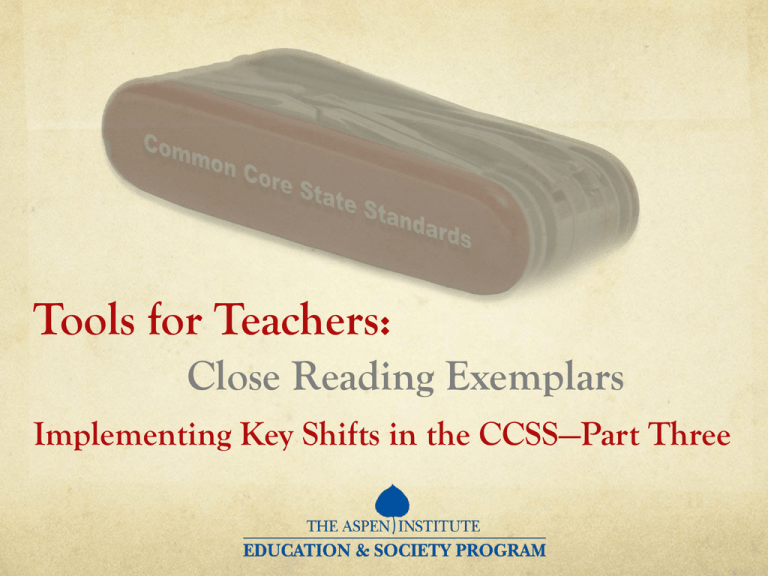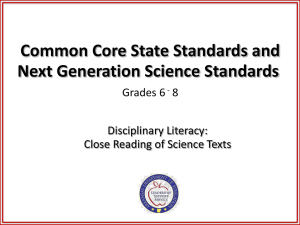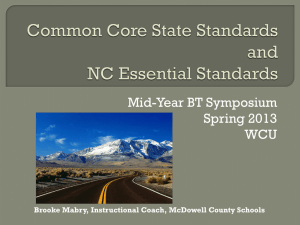Close Reading Exemplars
advertisement

Tools for Teachers: Close Reading Exemplars Implementing Key Shifts in the CCSS—Part Three Session Objectives As a result of this session, participants will… Learn how to support rigorous CCSS-aligned reading instruction with close reading exemplars that embody key shifts in the CCSS. Examine the characteristics of close reading exemplars. Learn about the importance of a systematic focus on academic vocabulary within CCSS-aligned instruction. Understand best practices for creating close reading exemplars. Explore methods for delivering effective close reading instruction that cultivates students’ interest in the text, responsibility for leading discussions and performing analysis, and the confidence and stamina necessary for gradual release to independence and proficiency. Key Shifts in the Standards Designing Instruction about Complex Texts Mastery of complex text is achieved through wellsequenced text-dependent questions that rely on evidence drawn from the text, attention to academic vocabulary & text structures, and scaffolding that retains the experience of text complexity. What are Close Reading Exemplars? Pulls together several of the key shifts within the CCSS into a single methodological approach towards close reading: Focus on complex text that is not over-scaffolded with background information prior to the close read. Use of text-dependent questions. Relies on evidence extracted from the text. Emphasizes the importance of understanding academic vocabulary and focusing on text structures in context. Links reading complex texts to culminating speaking, listening, and writing activities that are text- and evidence-based. Why Design through Close Reading Exemplars Matters Creates intentionally-focused opportunities in the classroom and across the curriculum to slow down and read texts closely. Allows teachers and students to systematically investigate texts for their meaning and purpose. Reliance on an integrated set of text-dependent questions leads to deeper holistic engagement with the material. Time to Reflect Close reading exemplars pull together several key shifts within the CCSS into a single methodological approach towards reading complex texts. Why Design with a Focus on Academic Vocabulary Matters Teaching focused on academic vocabulary is linked to significant gains in comprehension. The lack of systematic instruction has been shown to be a leading cause of the achievement gap. Thus the CCSS stress the importance of contextual instruction around “Tier 2” academic vocabulary. Academic Vocabulary and the CCSS: The Three Tiers Tier 1: The basic and concrete words of everyday speech; examples include walk, said, and car. Tier 3: Highly specialized, domain-specific vocabulary used to describe content knowledge; examples include oligarchy, photosynthesis, and carburetor; their low occurrence in texts typically leads to them being explicitly defined by the teacher or in the text itself (e.g. “White supremacy was enforced through segregation laws called ‘Jim Crow’”). Tier 3 words are best taught in the context of a coherent course of study in which subject matters are integrated and coordinated across the curriculum and domains become familiar to the student over several days or weeks. Academic Vocabulary and the CCSS: The Three Tiers Tier 2: Precise and more abstract words typically found in written texts; examples include saunter, boasted, and vehicle; referred to as high utility general academic vocabulary because of their frequent appearance across content areas, rich representational quality, multiple meanings depending on context, and connection to other words; seldom defined or scaffolded within texts. The contextual analysis of Tier 2 words should be the academic vocabulary focus within close reading exemplars. Tools for Selecting Academic Vocabulary Because there is a larger number of Tier 2 words than can be taught directly in a lesson, teachers must be strategic in selecting vocabulary to focus on when teaching a text. Academic Vocabulary and Real Texts “The earliest arrivals found places as close as possible to the steps of the great marble monument. As the crowd grew, it spread back along the Mall, stretching around both sides of the long reflecting pool and extending beyond to the base of the Washington Monument, threequarters of a mile away. Baby carriages were parked among the trees. Folks cradled sleeping infants in their arms and held youngsters by the hand or propped up on their shoulders. Uniformed Boy Scouts moved through the festive holiday throng handing out programs.” Academic Vocabulary and Real Texts “The earliest arrivals found places as close as possible to the steps of the great marble monument. As the crowd grew, it spread back along the Mall, stretching around both sides of the long reflecting pool and extending beyond to the base of the Washington Monument, threequarters of a mile away. Baby carriages were parked among the trees. Folks cradled sleeping infants in their arms and held youngsters by the hand or propped up on their shoulders. Uniformed Boy Scouts moved through the festive holiday throng handing out programs.” Time to Reflect Effective CCSS-aligned instruction is designed with a focus on systematically developing students’ “Tier 2” academic vocabulary. Close Reading Exemplars and Real Texts The shifts to instruction surrounding Design when Teaching Complex Texts manifest themselves most clearly when examining Close Reading Exemplars. Designing a Close Reading Exemplar Close reading exemplar templates for students should: Include the text selected for close reading with only those words glossed that could not be deciphered from context. Stress both independent silent reading of the text as well as reading the text out loud to support fluency. Designing a Close Reading Exemplar Close reader exemplar templates for teachers should: Present the text alongside the questions about it. Retain the focus on vocabulary (both taught in context and those words that are glossed). Include synoptic answers for teachers to the questions for easy reference. Tools for Designing Close Reading Exemplars Key elements that should appear in Close Reading Exemplars to create lessons that have a text-dependent focus: Goals and CCSS Connection Sequenced Text Dependent Questions Extension Activities Next Steps: Practice Creating Close Reading Exemplars Frederick Douglass’ “Men of Color, To Arms!” Time to Reflect Mastery of complex text is achieved through wellsequenced text-dependent questions that rely on evidence drawn from the text, attention to academic vocabulary & text structures, and scaffolding that retains the experience of text complexity. Delivering Instruction about Complex Texts Teachers use close reading to cultivate in students interest in the text, responsibility for leading discussions and performing analysis, and the confidence and stamina necessary for gradual release to independence and proficiency. Why Delivery about Complex Text Matters The CCSS convey specific expectations regarding student performance. Teachers should cultivate key student capacities integral to achieving these goals. Thus the CCSS stress not how to teach but what to teach: close reading, evidence-based analysis, and cogent reasoning—all culminating in a gradual release to independence and proficiency. Language in Teaching Effectiveness Rubrics What Kind Of Questions Should Teachers Ask? “higher-level questions” “higher order questions” “effective questioning” “questions push students beyond their initial thinking” “variety of questions” “questions challenge students to think” “questions that result in critical thinking and problem solving” How Shifts Would Impact Teaching Effectiveness What Kind Of Questions Should Teachers Ask? “questions that are closely tied to the text itself” “questions that require students to extract evidence from the text” “high-quality questions that require students to make inferences from what is stated in the text” “sequenced series of questions that build depth of understanding” “questions that pay attention to text structures” “questions that focus on academic vocabulary” Next Steps: Self-Assessment for Teaching Complex Texts 1. Make selfassessment a regular part of your own teaching practice. 2. Own the evaluation system rather than it owning you. 3. Be intentional in the depth of questions asked, design of lessons, and delivery of instruction. Tools for Measuring Delivery: Teaching Complex Texts Evaluation Evaluation Criteria keyed to critical areas discussed in Depth, Design, and Delivery. Criteria focus on “standards based learning objectives”: close reading, text dependent questions, Tier 2 vocabulary, text complexity, and gradual release to independence and proficiency. Next Steps: Teachers Coaching Each Other California researchers* … conducted a five-year study of teacherskill development in eighty schools, and noticed something interesting. Workshops led teachers to use new skills in the classroom only ten per cent of the time. Even when a practice session with demonstrations and personal feedback was added, fewer than twenty per cent made the change. But when coaching was introduced—when a colleague watched them try the new skills in their own classroom and provided suggestions—adoption rates passed ninety per cent. A spate of small randomized trials confirmed the effect. Coached teachers were more effective, and their students did better on tests. - Atul Gawande, “Personal Best” *For more information, see research conducted by Bruce Joyce and Beverly Showers. Time to Reflect Teachers use close reading to cultivate in students interest in the text, responsibility for leading discussions and performing analysis, and the confidence and stamina necessary for gradual release to independence and proficiency. Teaching Complex Texts: Summing Up Ask in-Depth Questions Design Close Reading Instruction Deliver Instruction Intentionally








